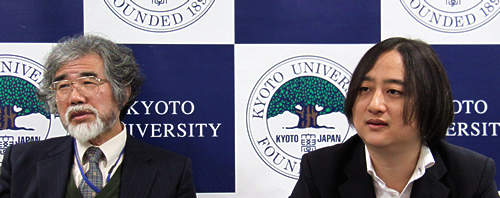[Dev Cell] Protecting the Genome: New Transposon-Silencing Protein Discovered
December 15, 2009
In discovering a new protein that protects the germline genome by silencing transposable genes, researchers have successfully identified host defense mechanisms. These findings, appearing in the latest issue of the journal Developmental Cell, can potentially aid in analyzing a cause of male sterility as well as expand the boundaries of epigenetic regulation.
This work has included contributions from Kyoto University, the University of Tokyo, the National Institute of Genetics (Japan), the Mitsubishi Kagaku Institute of Life Sciences, the National Research Institute for Child Health and Development (Japan), the University of Colorado School of Medicine, the European Molecular Biology Laboratory (EMBL), and the Research Institute of Molecular Pathology (IMP, Austria).
A Preview of this paper appeared in the same issue of Developmental Cell, in recognition of the influential nature of this finding.
 (News Release PDF: 260KB) |
 Prof. Norio Nakatsuji (left) and Asst. Prof. presenting their findings at a press conference (Dec. 15, 2009) |
![]() The TDRD9-MIWI2 Complex Is Essential for piRNA-Mediated Retrotransposon Silencing in the Mouse Male Germline
The TDRD9-MIWI2 Complex Is Essential for piRNA-Mediated Retrotransposon Silencing in the Mouse Male Germline
Masanobu Shoji, Takashi Tanaka, Mihoko Hosokawa, Michael Reuter, Alexander Stark, Yuzuru Kato, Gen Kondoh, Katsuya Okawa, Takeshi Chujo, Tsutomu Suzuki, Kenichiro Hata, Sandra L. Martin, Toshiaki Noce, Satomi Kuramochi-Miyagawa, Toru Nakano, Hiroyuki Sasaki, Ramesh S. Pillai, Norio Nakatsuji and Shinichiro Chuma
Developmental Cell, Volume 17, Issue 6, 775-787, 15 December 2009
doi:10.1016/j.devcel.2009.10.012
[Abstract]
Host-defense mechanisms against transposable elements are critical to protect the genome information. Here we show that tudor-domain containing 9 (Tdrd9) is essential for silencing Line-1 retrotransposon in the mouse male germline. Tdrd9 encodes an ATPase/DExH-type helicase, and its mutation causes male sterility showing meiotic failure. In Tdrd9 mutants, Line-1 was highly activated and piwi-interacting small RNAs (piRNAs) corresponding to Line-1 were increased, suggesting that feedforward amplification operates in the mutant. In fetal testes, Tdrd9 mutation causes Line-1 desilencing and an aberrant piRNA profile in prospermatogonia, followed by cognate DNA demethylation. TDRD9 complexes with MIWI2 with distinct compartmentalization in processing bodies, and this TDRD9-MIWI2 localization is regulated by MILI and TDRD1 residing at intermitochondrial cement. Our results identify TDRD9 as a functional partner of MIWI2 and indicate that the tudor-piwi association is a conserved feature, while two separate axes, TDRD9-MIWI2 and TDRD1-MILI, cooperate nonredundantly in the piwi-small RNA pathway in the mouse male germline.
* Impact factor: 12.882
(3rd/38 in Developmental Biology, Thomson Reuters 2008 Journal Citation Reports)
[Related links]
 Preview: Defending the Genome in Tudor Style
Preview: Defending the Genome in Tudor Style
Godfried W. van der Heijden and Alex Bortvin
Developmental Cell, Volume 17, Issue 6, 745-746, 15 December 2009
doi:10.1016/j.devcel.2009.11.007
[Abstract]
Repression of transposable elements is crucial for the survival of germ cells. In this issue of Developmental Cell, Shoji et al. provide evidence that a Tudor domain protein TDRD9 partners with MIWI2 to specifically silence LINE-1 transposons in the fetal germline of male mice.- Summarized on the website of the
 Germline Developmental and Epigenome Network, which receives funding from the Japanese Ministry of Education, Culture, Sports, Science and Technology (in Japanese)
Germline Developmental and Epigenome Network, which receives funding from the Japanese Ministry of Education, Culture, Sports, Science and Technology (in Japanese)
[Contact]
Yutaka Iijima | pr@icems.kyoto-u.ac.jp
Manager, International Public Relations
Institute for Integrated Cell-Material Sciences (iCeMS), Kyoto University
[Media coverage]
 Yomiuri Shimbun (Dec 15, 2009 evening edition page 2)
Yomiuri Shimbun (Dec 15, 2009 evening edition page 2)- KBS Kyoto (television news, Dec 15, 2009 11:55 and 17:30)
- Nikkei Sangyo Shimbun (Dec 15, 2009 page 11)
 Kyoto Shimbun (Dec 15, 2009 page 30)
Kyoto Shimbun (Dec 15, 2009 page 30) Sankei Shimbun (Dec 15, 2009 page 23)
Sankei Shimbun (Dec 15, 2009 page 23) Chunichi Shimbun (Dec 15, 2009 page 31)
Chunichi Shimbun (Dec 15, 2009 page 31) Tokyo Shimbun (Dec 15, 2009)
Tokyo Shimbun (Dec 15, 2009) Nishishippon Shimbun (Dec 15, 2009)
Nishishippon Shimbun (Dec 15, 2009)- Nikkan Kogyo Shimbun (Dec 15, 2009 page 23)
- Mainichi Shimbun (Dec 15, 2009 page 3)
 Fukui Shimbun (Dec 15, 2009)
Fukui Shimbun (Dec 15, 2009) Kyodo News (Dec 15, 2009 web)
Kyodo News (Dec 15, 2009 web)
